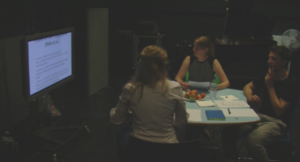For this qualitative investigation, two focus groups were put together, involving experts from the fields of digital art, art curation and digital technology. Using the application that incorporates the four interactivity modes, the experts were consulted on the evaluation metrics of the different types of interactivity towards the phases of user engagement.
Some of the outcomes from the discussions are given below:
Trends
There is a trend within big museums to upgrade their exhibitions and make them more interactive (on- and offline). Especially in large museums, guided tours that highlight the well-known artefacts from a collection give the visitor a much better understanding of the whole exhibition. In order not to overwhelm the user, an approach of ‘less is more’ should be followed in the curation process. Further, it is important to provide an exhibition space that guides the visitors without constraining them.
Presentation Space
In virtual worlds, such as Second Life, the design of the space and the laws of interaction most often mirror what we are used to in the real world, without taking full advantage of the virtual medium and its possibilities. Avatars look and behave in ways we are used to in the real world; virtual buildings mirror the standards and the architecture from reality as well. Virtual media offer many more options that are not possible in the real world, so presentation should not be constrained to what we know from the real world. Overall, the virtual world should not recreate the real one. For better perception, video-based artworks are usually displayed in dark rooms with no natural light. Some kind of eye-catching art piece is commonly displayed at the entrance to an exhibition space to gather the visitors’ initial attention. Good examples of interactive artworks were considered to be those, which make the user forget about the ‘real world’ and have a very short learning curve for the user to understand the purpose and the interaction tool of the artwork. The user should not feel the need to get used to the system in order to interact with it fully. The digital 3D representation of space is usually hard to believe and can disturb the actual viewing of the art presented in it.
Content vs Context
Overall, it is not so much about the content any more but about the context, and the user experience provided. Thus, in the future the focus should be targeted more towards the engineering of the context and being able to augment the user’s perception. Then the user’s own perception will become the content. There is a lot of already existing content. Thus, the future aim of designers and curators should be to create a valuable perception with the content, rather than to develop more and more new artefacts. Museums nowadays are aiming, especially with the help of technology, to bring the content to the user in an approachable and interesting manner. However, most digital representations of visual art are in the form of simple images. It is evident that there is a lack of prominent good online examples of interactive digital art presentations.
Physical vs Digital Art Presentation
The use of digital headsets as an art medium tool or for the presentation of art digitally can be very immersive. However, many virtual reality examples using headsets, like the Oculus Rift, focus much more on the technology itself than on the presented content. Going into a physical art exhibition space and looking at an artwork online are two very different experiences. There are a lot of contextual and social attributes that go with visiting a gallery. The experience of going to a physical art gallery is accompanied by smells, sounds, other visitors, and also things like having a cup of tea, going to the gift shop, meeting with a friend, etc. When the art is presented on a screen through a gallery website, it becomes more like a research process. In a way, it is a more formal experience, since the user is not ‘just wandering around’ as they might do in the physical space; rather, they are usually on the specific website for a reason.

